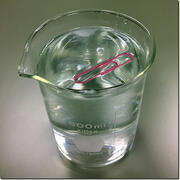Water Meniscus
A meniscus is a curve in the surface of a molecular substance (water, of course) when it touches another material. With water, you can think of it as when water sticks to the inside of a glass.
• Water Science School HOME • Water Properties topics •
What is a meniscus?
A meniscus is a curve in the surface of a molecular substance (water, of course) when it touches another material. With water, you can think of it as when water sticks to the inside of a glass.
Why a meniscus occurs
Adhesion is responsible for a meniscus and this has to do in part with water's fairly high surface tension. Water molecules are attracted to the molecules in the wall of the glass beaker. And since water molecules like to stick together, when the molecules touching the glass cling to it, other water molecules cling to the molecules touching the glass, forming the meniscus. They'll travel up the glass as far as water's cohesive forces will allow them, until gravity prevents them from going further. Cohesion is an intermolecular attraction between like molecules (other water molecules in this case).

Sad tale of a meniscus misread
Few people take the time to consider the importance of water menisci in their lives. But, imagine this chilling scenario:
In your high-school chemistry final exam you mistakenly read a meniscus as 21.9 milliliters (ml) instead of the correct 21.7 ml (in this picture), and thus you get an 89 on the test instead of a 90. Your GPA falls from 4.00 to 3.99 and you don't get into that engineering college program you wanted. Consequently, you don't get that prestigious engineering job, where, 20 years later, you would have invented a new water-based chemical to allow rubber to grip better. Sadly, 10 years later, a mother and her adorable 4-year old daughter are leaving the ice cream store and the little girl, whose shoes don't have your un-invented coating, slips on a napkin and drops her ice cream cone. She cries at her loss ... because you misread the meniscus in the 12th grade.
The moral of this fictional tale is that it is important to read the measurement correctly, and yes, in the picture above, the true volume in the graduated cylinder is at the bottom of the water level—21.7 milliliters, not 21.9.

"Upside down" meniscus
As this picture shows, a meniscus can go up or down. It all depends on if the molecules of the liquid are more attracted to the outside material or to themselves. A concave meniscus, which is what you normally will see, occurs when the molecules of the liquid are attracted to those of the container. This occurs with water and a glass tube. A convex meniscus occurs when the molecules have a stronger attraction to each other than to the container, as with mercury and glass. A flat meniscus occurs with water in some types of plastic tubes; tubes made out of material that water does not stick to. In any case, you get the true volume of the liquid by reading the center of the liquid in the tube, which will the lowest vertical point of the liquid.
Learn more about related topics to water menisci and other water properties.
Water Properties Information by Topic
Surface Tension and Water
Capillary Action and Water
Adhesion and Cohesion of Water
Pictures and multimedia resources about water menisci and other water properties.
A meniscus is a curve in the surface of a molecular substance (water, of course) when it touches another material. With water, you can think of it as when water sticks to the inside of a glass.
• Water Science School HOME • Water Properties topics •
What is a meniscus?
A meniscus is a curve in the surface of a molecular substance (water, of course) when it touches another material. With water, you can think of it as when water sticks to the inside of a glass.
Why a meniscus occurs
Adhesion is responsible for a meniscus and this has to do in part with water's fairly high surface tension. Water molecules are attracted to the molecules in the wall of the glass beaker. And since water molecules like to stick together, when the molecules touching the glass cling to it, other water molecules cling to the molecules touching the glass, forming the meniscus. They'll travel up the glass as far as water's cohesive forces will allow them, until gravity prevents them from going further. Cohesion is an intermolecular attraction between like molecules (other water molecules in this case).

Sad tale of a meniscus misread
Few people take the time to consider the importance of water menisci in their lives. But, imagine this chilling scenario:
In your high-school chemistry final exam you mistakenly read a meniscus as 21.9 milliliters (ml) instead of the correct 21.7 ml (in this picture), and thus you get an 89 on the test instead of a 90. Your GPA falls from 4.00 to 3.99 and you don't get into that engineering college program you wanted. Consequently, you don't get that prestigious engineering job, where, 20 years later, you would have invented a new water-based chemical to allow rubber to grip better. Sadly, 10 years later, a mother and her adorable 4-year old daughter are leaving the ice cream store and the little girl, whose shoes don't have your un-invented coating, slips on a napkin and drops her ice cream cone. She cries at her loss ... because you misread the meniscus in the 12th grade.
The moral of this fictional tale is that it is important to read the measurement correctly, and yes, in the picture above, the true volume in the graduated cylinder is at the bottom of the water level—21.7 milliliters, not 21.9.

"Upside down" meniscus
As this picture shows, a meniscus can go up or down. It all depends on if the molecules of the liquid are more attracted to the outside material or to themselves. A concave meniscus, which is what you normally will see, occurs when the molecules of the liquid are attracted to those of the container. This occurs with water and a glass tube. A convex meniscus occurs when the molecules have a stronger attraction to each other than to the container, as with mercury and glass. A flat meniscus occurs with water in some types of plastic tubes; tubes made out of material that water does not stick to. In any case, you get the true volume of the liquid by reading the center of the liquid in the tube, which will the lowest vertical point of the liquid.
Learn more about related topics to water menisci and other water properties.
Water Properties Information by Topic
Surface Tension and Water
Capillary Action and Water
Adhesion and Cohesion of Water
Pictures and multimedia resources about water menisci and other water properties.





